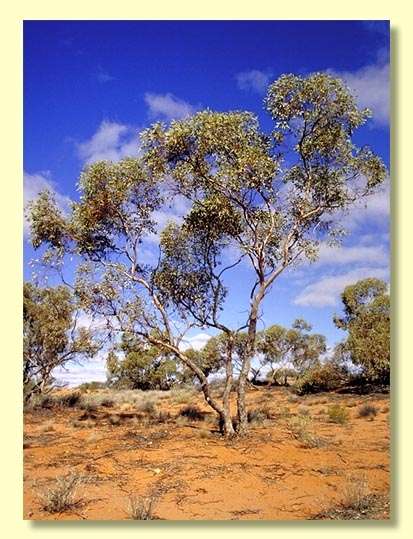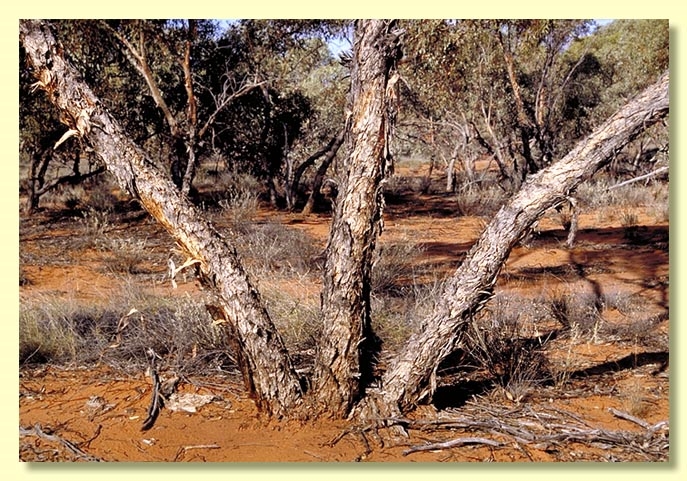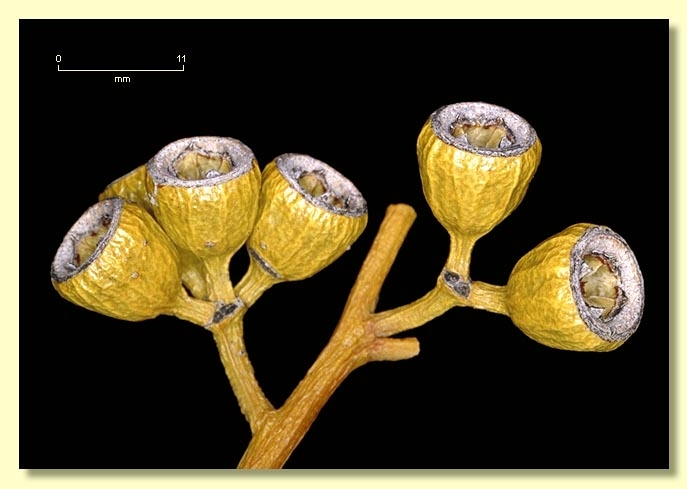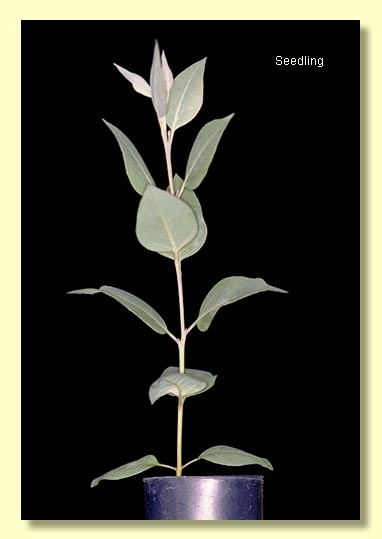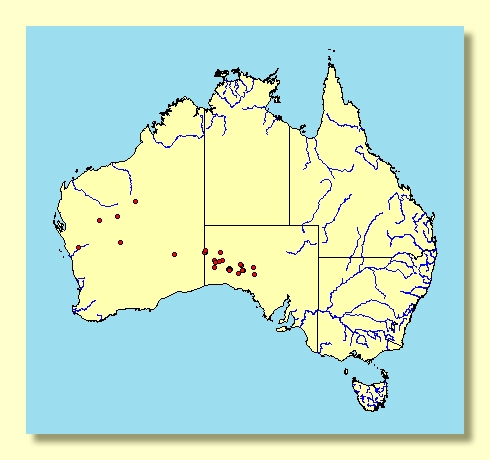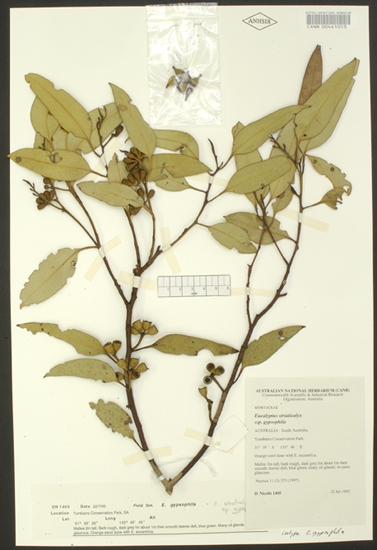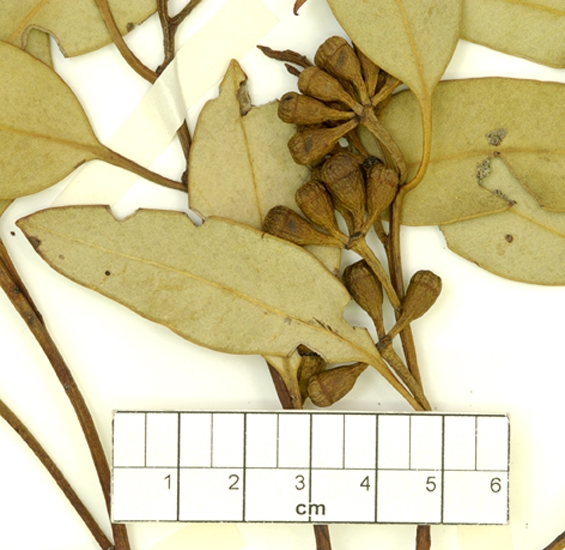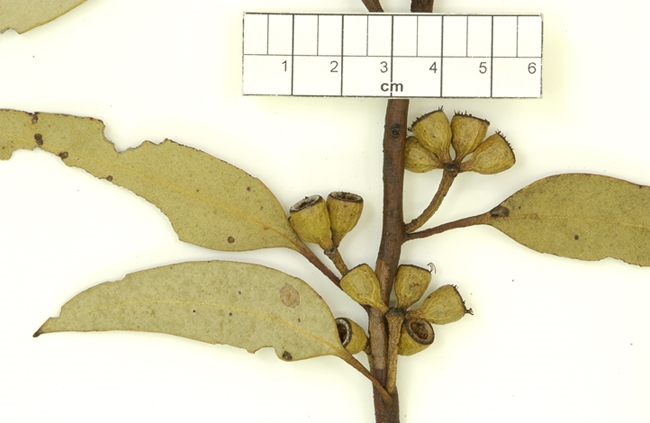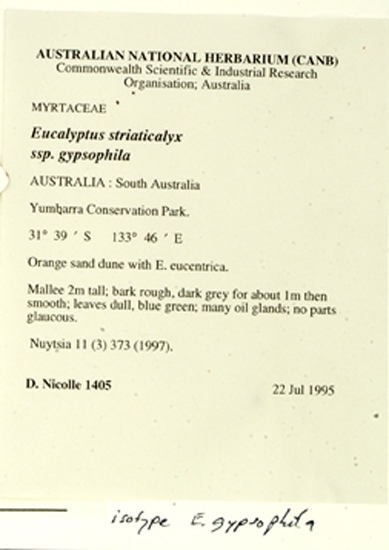Euclid - Online edition
Eucalyptus gypsophila
Eucalyptus | Symphyomyrtus | Dumaria | Rufispermae
Bark rough for lower half of trunk, grey to brown, loose and flaky, smooth above light grey over pinkish grey to coppery cream.
Branchlets with oil glands in the pith.
Juvenile growth (coppice or field seedlings to 50 cm): stems square to rounded in cross-section, slightly glaucous; juvenile leaves always petiolate, opposite for ca 3 nodes then alternate, orbicular at lowest nodes becoming ovate, 3–5.5 cm long, 2.5–4.5 cm wide, base rounded to tapering, slightly glaucous to blue-grey.
Adult leaves alternate, petioles 1–2.5 cm long; blade lanceolate, 7.5–12(13.5) cm long, (1)1.5–2.5(3.5) cm wide, base tapering to petiole, margin entire, apex pointed, dull blue-grey to grey-green or slightly glaucous, side-veins at an acute or wider angle to midrib, reticulation dense to very dense, intramarginal vein present, oil glands intersectional.
Inflorescence axillary unbranched, peduncles 0.5–2 cm long, buds (?7)9 to 19 per umbel, pedicellate, pedicels 0.2–0.6 cm long. Mature buds more or less obovoid (0.8–1.4 cm long, 0.5–0.9 cm wide), glaucous or non-glaucous, scar present, operculum rounded to conical (0.25–0.6 cm long), radially striate, stamens inflexed, anthers cuboid to wedge-shaped, versatile, sub-dorsifixed, dehiscing by longitudinal slits, style long and straight, stigma more or less blunt, locules 4–6, the placentae each with 4 vertical rows of ovules. Flowers creamy white.
Fruit pedicellate, pedicels 0.2–0.5 cm long, obconical to cylindrical, 0.7–1.2 cm long, 0.7–1.1 cm wide, glaucous or non-glaucous, disc descending, valves 4–6, rim level or scarcely exserted.
Seeds red-brown and glossy, 1.5–3.5 mm long, flattened-ovoid and sometimes slightly angular in outline, dorsal surface shallowly reticulate, hilum ventral.
Cultivated seedlings (measured at ca node 10): cotyledons reniform; stems square in cross-section, slightly glaucous or not glaucous; leaves always petiolate, opposite for 3 to 5 nodes then alternate, ovate, 3.5–7.5 cm long, 2.5–4 cm wide, glaucous weathering to grey-green.
Flowering has been recorded in July, August and December.
A mallee widespread across arid Western Australia from the Kennedy Range, Marymia, Savoury Creek and Blackstone Range in the north, south to Tallering Peak north-east of Geraldton and Yeelirrie, extending south-east to the Great Victoria Desert as far as Yumbarra Conservation Park north of Ceduna in South Australia; plants further east on sandy station country north of the gawler ranges e.g. Yardea and Hiltiba also match this species. It occurs on sandy gypseous sites. The bark is rough on the lower half of the stems and the adult leaves are dull, blue-green to blue-grey.
In the classification of Brooker (2000) Eucalyptus gypsophila belongs in Eucalyptus subgenus Symphyomyrtus section Dumaria having these features: buds initially with two opercula the outer shed early, stamens strongly inflexed, ovules in 4 rows on the placentae and cotyledons reniform. Within section Dumaria the species belongs to a large subgroup of closely related species (series Rufispermae, 37 described species and subspecies) diagnosed by glandular pith in the branchlets, anthers cuboid to wedge-shaped, versatile, and by the reddish brown and glossy, flattish seeds which are unique to the series.
Many of the species in series Rufispermae are weakly defined, but divide roughly into groups depending on the tree or mallee habit, smooth or rough bark and the distinction between the dull- and glossy-leaved species. E. gypsophila, a species usually found on red sands over powdery limestone around salt lakes, differs from the related E. canescens, which occurs on red sand dunes, by the narrower leaves, smaller buds with a less ribbed operculum and smoother fruits. It was included until recently in E. striaticalyx, which differs in being a tree occuring on red-brown loams on flats around salt lakes. In the north-west of its distribution E. gypsophila has been confused with E. repullulans, a smooth-barked mallee that occurs on arid hillslopes and mountaintops with skeletal soil, restricted to the Pilbara region and disjunctly at Wingellina in central Australia.
In 2001 Hill et al published the species E. infracorticata from the Great Victoria Desert east of Kalgoorlie in Western Australia. It seems to be morphologically close to E. gypsophila, having slightly smaller buds and fruit (E. infracorticata with fruit to 0.6 cm diameter, compared with E. gypsophila fruit 0.7–1.1 cm diameter). E. infracorticata is known from one locality near Queen Victoria Springs, where it grows in open mallee shrubland with Triodia on red sandy desert loam. The authors of EUCLID currently include this in E. gypsophila pending field assessment as specimens are very few and incomplete.
Plants found north of the Gawler Ranges in South Australia may be smooth-barked and perhaps show some genetic influence from Eucalyptus phenax.

